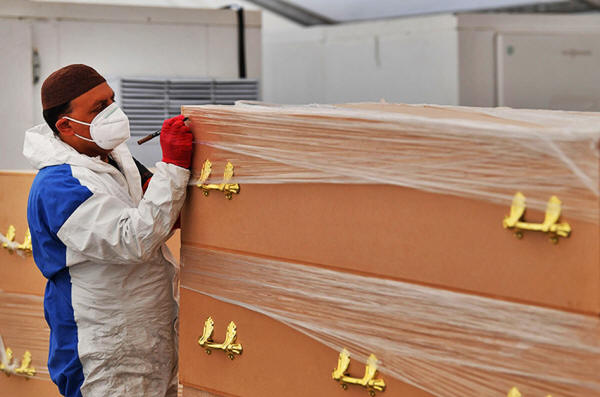|
(Getty
Images) how many lives have really been lost to the disease...
But nothing could be further from the truth...
That is why I and many of
my colleagues are so dismayed by changes introduced during the
coronavirus epidemic which mean that pathology has not been able to
play the role that it should have in helping to understand this new
disease.
They imagine days spent trudging across fields to reach murder scenes, Silent Witness-style, and nights sifting through arcane evidence to catch the perpetrators.
And a rare type of
pathologist - the forensic pathologist - does indeed do that.
We are experts in analyzing changes in the fabric of our bodies that result from disease.
Many diseases affect our tissues in ways that can be seen down the microscope, allowing them to be accurately diagnosed and monitored, particularly tumors and inflammations.
Every time a biopsy or surgical sample is taken, it comes to the histopathology lab to be examined.
Histopathology is often regarded as a 'gold standard' for diagnosis of diseases that change tissue structure. A clinical examination or X-ray may suggest that a tumor or fibrosis of the lung, say, is present, but you need to examine a tissue sample microscopically to be sure that it's really there, what type it is, and how advanced.
Tissue can also be
examined genetically to look for the presence of infectious agents
or cellular receptors that may determine how deadly it is.
But in this case the autopsies are not typically looking for evidence of foul play. They are usually requested by a coroner to ascertain the cause of death. Relatives, even doctors, are often surprised by the need for this in the world of modern medicine.
Surely all the examinations, tests and imaging carried out in life mean that the treating doctors know what was wrong with the patient when they die?
But no, it turns out that autopsies often reveal the unexpected.
Autopsy studies typically show major discrepancies between actual findings and clinical diagnosis in a quarter to a third of cases.
And in about a sixth of the cases, knowing about these hidden pathologies in life could have made differences to treatment that might have prevented death.
In the UK in recent
decades about one in six deaths have had an autopsy examination - a
deceased person's last gift to the living.
Autopsies also allow
sampling of tissues from more organs than is usually possible in
life, facilitating molecular and genetic studies.
Knowledge about all of these aspects was substantially acquired by study of tissue samples taken during life, and by autopsy examinations, with study of samples acquired after death.
There was much
uncertainty and worry at the time about how the disease was spread,
and possible contagion to healthcare workers and to the general
population. But work continued, and the results were of immense help
in understanding the disease and developing treatments.
We are still struggling to understand coronavirus. I can think of no time in my medical career when it has been more important to have accurate diagnosis of a disease, and understanding of precisely why patients have died of it.
Yet very early on in the
epidemic, rules surrounding death certification were changed - in
ways that make the statistics unreliable.
Guidance was issued which tends to reduce, rather than increase,
referrals for autopsy.
That has changed.
A video-link consultation in the four weeks prior to death is now felt to be sufficient for death to be attributed to Covid-19.
For deaths in care homes the situation is even more extraordinary.
In the words of the Office for National Statistics, this,
From 29 March the numbers of 'Covid deaths' have included all cases where Covid-19 was simply mentioned on the death certificate - irrespective of positive testing and whether or not it may have been incidental to, or directly responsible for, death.
From 29 April the numbers
include the care home cases simply considered likely to be
Covid-19.
Despite what you may have understood from the daily briefings, the shocking truth is that we just don't know...
Again, we don't know...
Despite claims that
they're all due to Covid-19, there's strong evidence that many,
perhaps even a majority, are the result of our responses
rather than the disease itself.
But at a time when autopsies could have played a major role in helping us understanding this disease, advice was given which made such examinations less likely than might otherwise have been the case.
The Chief Coroner issued guidance on 26 March which seemed designed to keep Covid-19 cases out of the coronial system:
And even guidance produced by the Royal College of Pathologists in February stated:
We need proper information to inform our responses to the virus, both clinical and societal.
Instead,
Officials should be releasing, as a matter of urgency, detailed information on the surge in deaths, both apparent Covid and non-Covid - particularly in care homes.
How many are dying of Covid acquired in hospitals...?
Data presumably exists on this too, but is not released.
One of the unappreciated tragedies of this epidemic so far is the huge lost opportunity to understand Covid-19 better.
We like to beat ourselves up for having the worst Covid death toll in Europe - but we will never know, because we decided not to count properly...
In a country that has
always prided itself on the quality of its facts and figures, the
missing Covid-19 data is a national scandal...
|


